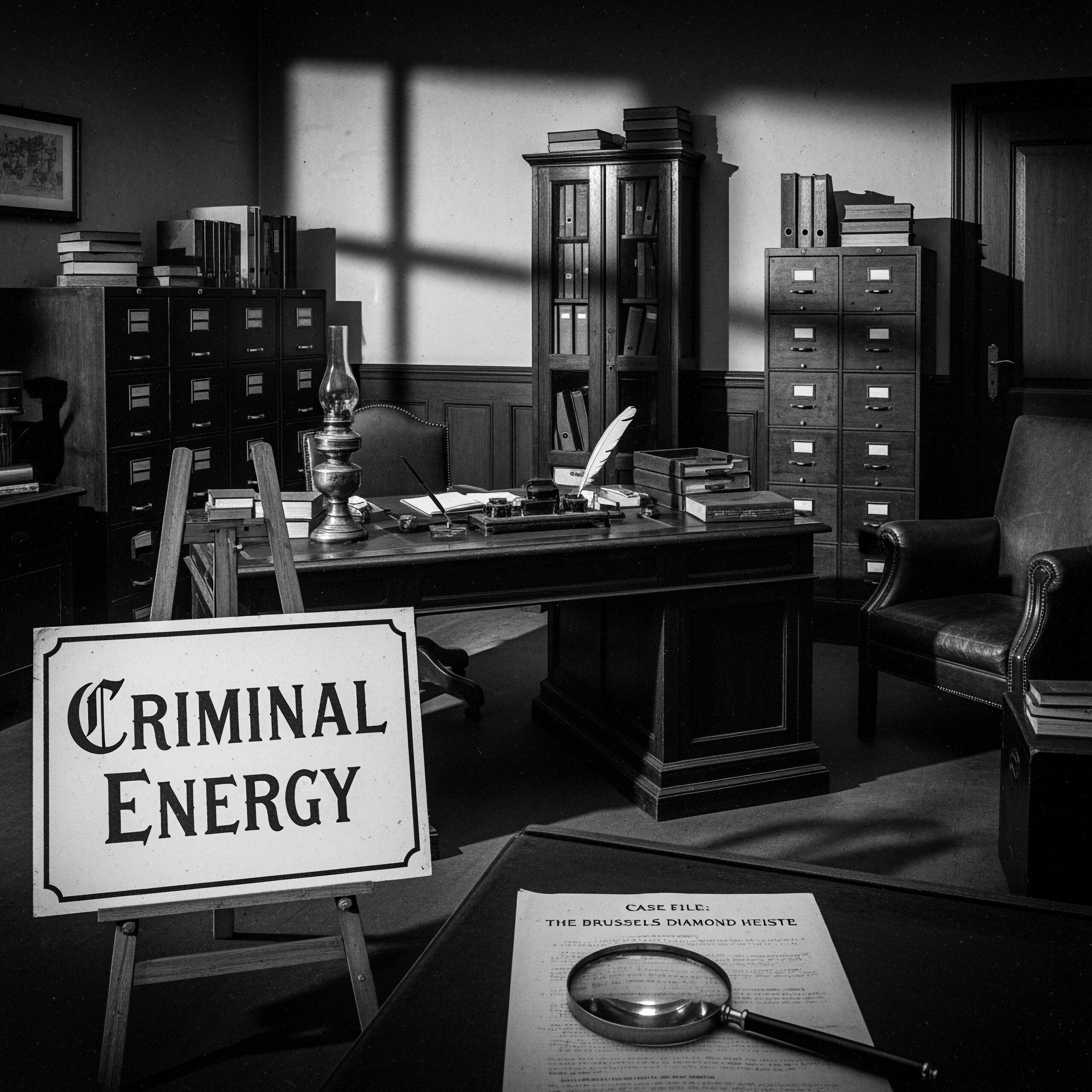The Peltzer case is one of the most spectacular criminal cases of the 19th century in Belgium. What began as a story of a failed marriage developed into an elaborate murder plot that shook Antwerp’s high society and continues to provide material for dramatic adaptations to this day. At the center of the story are three main characters: the successful lawyer Guillaume Bernays, his wife Julie, and the charismatic businessman Armand Peltzer. What initially appears to be a conventional love triangle develops into a complex web of intrigue and false suspicions due to the entanglements of those involved. Guillaume Bernays, a respected commercial and maritime law specialist, married the attractive Julie Pecher in 1872. But the marriage was ill-fated. After the difficult birth of their son Édouard, the couple grew increasingly estranged. Julie accused her husband of spending too much time at the office and having an affair with the housekeeper. Armand Peltzer entered this broken marriage in 1873. The charming widower sought Bernays’ help for his brothers, who were in financial difficulties. The client relationship developed into a close friendship – too close, as it later turned out. Soon, rumors were circulating in Antwerp about a liaison between Armand and Julie. When the situation threatened to escalate with Peltzer being banned from the house, he came up with a diabolical plan: Guillaume Bernays had to die. He enlisted his brother Léon, a failed businessman with a criminal past, to carry out the plan. To carry out the deed, the two brothers hatched a perfidious murder plot. Léon rented an office in Brussels under the pseudonym “Henry Vaughan.” He pretended to be a shipowner who needed Bernays’ legal expertise. Disguised with a wig, he lured the lawyer into the trap. On January 7, 1882, the plan was put into action. Léon Peltzer shot Guillaume Bernays in the neck in the Brussels office. The body remained undiscovered at first. To buy time, Léon Peltzer sent a letter written in English from Switzerland to the authorities, in which he confessed to a supposed accident as “Henry Vaughan.” Only then was Bernays’ body found on January 19. The police were initially in the dark. It was only when they published the “confession letter” in the press that the case began to move forward. A pharmacist from Verviers recognized Léon Peltzer’s handwriting and reported it to the police. After ten months of investigation, with over 300 requests for legal assistance and 107 witness interviews, the trial began in Brussels on November 27, 1882. Public interest was enormous. The newspapers reported daily on new details and twists and turns. Léon Peltzer became entangled in contradictions. His version of an accidental shot during an argument did not convince the jury. After a four-week trial, both brothers were found guilty. Léon Peltzer was the perpetrator who shot on behalf of his brother Guillaume Bernays. Both were sentenced to death. This sentence was commuted to life imprisonment. The further fate of those involved varied. Armand Peltzer died in 1885 after three years in prison in Leuven. His daughter Marguerite later led a middle-class life in Cologne. Léon Peltzer showed remorse and was released early in 1911. After years abroad, he returned to Belgium and drowned in the North Sea in 1922 under unexplained circumstances. Julie Bernays married her lawyer Fréderic Delvaux in 1886 and later worked as a journalist. She died in Antwerp in 1928. The Peltzer case continues to fascinate people today due to its many facets. The psychological complexity of the characters. The ingenious planning of the crime. The social entanglements. The dramatic twists and turns during the investigation. No wonder the case has been repeatedly adapted artistically in books and newspaper reports, as a play, in film productions, and even as a comic. The Peltzer case exemplifies how jealousy, wounded pride, and criminal energy can turn an initially harmless situation into a tragedy. It shows that even respectable citizens are capable of extreme actions when passion and calculation combine. The story of the Peltzer brothers is thus not only a spectacular criminal case, but also a timeless study of human depravity. It shows how thin the veneer of civilization can be and what consequences arise when people cross their moral boundaries. To this day, the case serves as a reminder that behind the respectable façade of bourgeois life, dramas often lurk that need only a small trigger to erupt into tragedy. Thus, even 140 years after the events, the Peltzer case remains relevant and instructive. The Peltzer case is not only spectacular, but also legally significant. Numerous aspects and methods of the investigations and trial proceedings at the time were groundbreaking for later criminal cases and their legal processing. For example, the Belgian police made extensive use of the expertise of graphologists for the first time to confirm the authenticity of the letters, which later became established as standard procedure in the investigation of document forgeries. In addition, the case led to increased cooperation between the various police authorities within Europe in order to combat cross-border crime more effectively. The international exchange of information and coordination in the arrest of the Peltzer brothers were early precursors of modern Interpol operations. The Peltzer case not only inspired extensive coverage in the contemporary press, but also a multitude of artistic works. Writers, playwrights, and filmmakers repeatedly found new material for stories that captivated audiences in this true crime case. Particularly noteworthy is the novel “Murder in the Shadow of the Cathedral” by Henri De Régnier, who adapted the case for literature and delved deeply into the psychological abysses of the protagonists. Plays and films keep the memory of the case alive and impressively show how crime moved people then and now. Even comics and graphic novels have reinterpreted the case, making it accessible to a younger generation. Even though the Peltzer case dates back more than a century, valuable insights can still be gained from it today. It shows that jealousy and greed can drive even the most respectable people to commit crimes. These human abysses are universal and timeless. The case reminds us that trust can easily be abused and that the boundaries between love and hate can often be blurred. The careful investigation and precise legal proceedings are also a reminder of how important a functioning legal system is for solving and punishing crimes. Only through meticulous investigative work and fair trials can justice and legal certainty be guaranteed. The Peltzer case remains an important part of Belgian criminal history. It vividly illustrates the dark side of human nature and the devastating effects that passion and betrayal can have. At the same time, it serves as an example of the advances in criminal investigation and legal practice that emerged from this case. Thus, the case remains not only a fascinating piece of history, but also an important lesson about the fragility of human relationships and the need for a strong legal system. Through numerous portrayals and adaptations in various media, the story of Guillaume Bernays, Julie, and the Peltzer brothers will live on in the future, both warning and entertaining.
By Isabella Mueller
Welcome to my journey through creativity and discovery! My name is Isabella Mueller, and I invite you to explore the fascinating creative universes I create through my blogs. Since 2020, I have been dedicating my passion to telling captivating stories that are mysterious, historical, and emotional. My goal is not only to entertain, but also to inspire reflection and awaken the spirit of discovery in each of us. At isabellas.blog, the suspense of crime stories is combined with exciting travel tips. Imagine wandering through the picturesque streets of a new city, uncovering dark secrets hidden in the shadows of its history. Every piece on my blog is designed to make the heart of every crime fiction fan beat faster while sparking curiosity about unknown places. Here, you are invited to experience the thrill of the unknown and the beauty of our world—a perfect combination for all adventure seekers! My second blog, akteq.com, is all about true, unsolved crime stories. Under the motto “akteQ: Cold Case Stories,” I reveal the eerie and often tragic stories behind unsolved cases. Together, we can explore the mysteries of the past and delve deep into the human psyche. What really happened? Who were the people behind these mysterious events? In this blog, I invite you to ask questions and find the answers that often remain hidden in the dark. You can find another exciting chapter in my blogging career at thecastles.org. Here, I embark on an enchanting journey through the history of castles and palaces. Pause for a moment as you discover the stories hidden within the walls of these ancient structures. “Explore the enchantment, discover the history – your journey begins at thecastles.org!” These words are more than just a slogan; they are an invitation to anyone who wants to combine history and magic. Be inspired by the impressive stories and the fascination of bygone eras! But that's not all! At kripo.org, you'll find a comprehensive online magazine for real criminal cases. Immerse yourself in the world of crime, learn about the real stories behind the headlines and the people who are involved in solving them. With criminal.energy, I take you on a journey through the gripping stories of true crimes in which villains are hunted, caught, and convicted. The search for justice and the confrontation with the unknown are at the center of it all. TrueCrime Blog 187.news takes you into the depths of crime. And for those who want to travel the world, wanderlust.plus offers the opportunity to explore the world, one adventure at a time. It's all about the love of exploration and the joy of discovering new cultures and landscapes. Finally, truecrime.ch invites you to discover the dark side of Switzerland and Europe: true crimes, true stories. Let's discover together the stories that shape the world around us. I look forward to accompanying you on this exciting journey and hope you will share many unforgettable moments with me!

